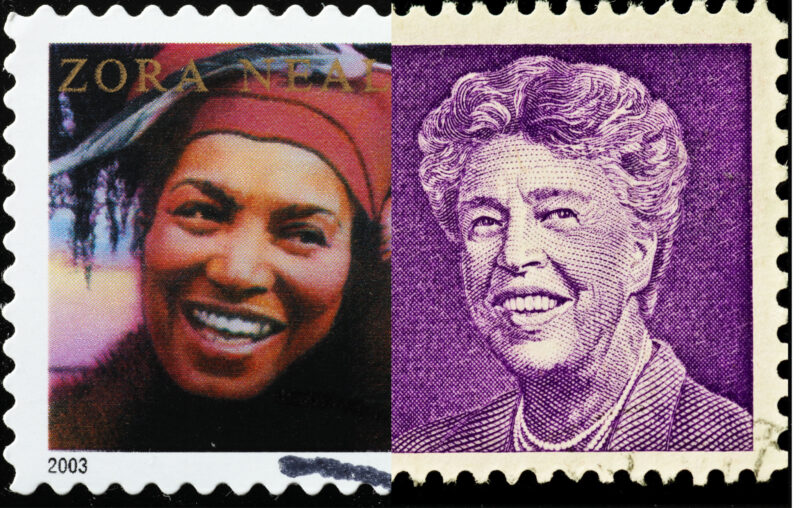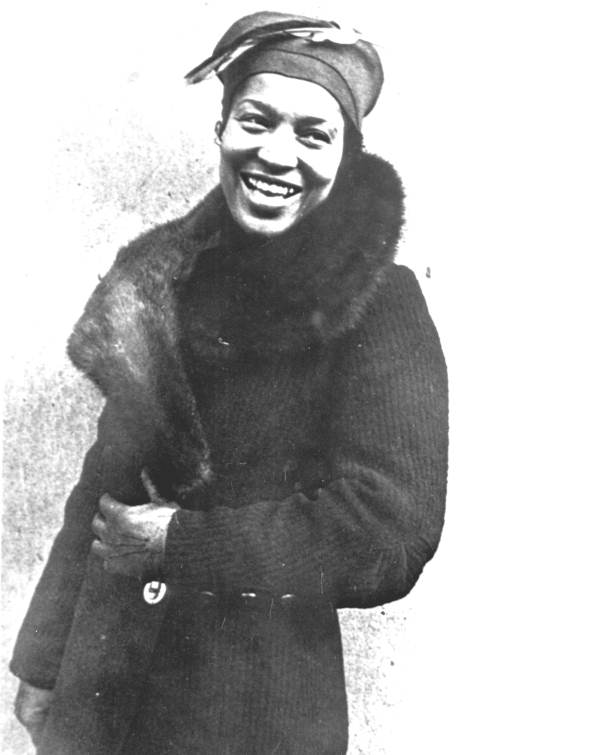Zora and Eleanor: Toward a Fuller Understanding of the First Lady’s Civil Rights Legacy

Eleanor Roosevelt and Zora Neale Hurston were pivotal figures in African American history during the twentieth century, the first for her personal fight against racial discrimination in an administration that often fell short in that regard, and the second for her contributions as a folklorist and novelist. Both women evoke such strong feelings that many habitually refer to them by their first names. While Eleanor Roosevelt’s views on Zora Neale Hurston remain a mystery, the reverse was most certainly not the case. Hurston had strong opinions about Eleanor Roosevelt, and especially had much to say about the single event most identified with the First Lady’s tenure: her public resignation from the Daughters of the American Revolution (DAR) because it barred African-American contralto Marian Anderson from performing at Constitution Hall.
The story is generally familiar. Anderson had won world acclaim by the late 1930s. Shortly after returning from a European tour, her manager sought an engagement at the prestigious Constitution Hall in Washington, DC. The DAR, which was the owner, denied the application because of a “whites only” policy for performers. The controversy reached a boiling point when Eleanor Roosevelt publicly resigned from the DAR in protest. The NAACP, in cooperation with Secretary of Interior Harold Ickes, responded by organizing an open-air concert for Anderson at the Lincoln Memorial. Millions of Americans listened to the concert attended by prominent figures in both parties. That event gave a major psychological boost to the cause of civil rights and further solidified black support for the Democratic Party.
This standard account is broadly true, but incomplete. As Hurston’s writings point out, it omits a key player: the Board of Education of the District of Columbia. Any full understanding of the controversy must take note of it. Even before the details of the DAR’s final decision had become entirely clear, Anderson’s manager had applied to the Board of Education to use the auditorium of the local all-white and segregated Central High School. Superintendent of DC Schools Frank W. Ballou responded that letting Anderson sing at Central High School would, in the view of the Board, contradict the spirit of a 1906 federal law requiring segregated schools for DC. A new Marian Anderson Citizens’ Committee (MACC), working in tandem with the NAACP, mobilized in protest beginning on February 20. It asked: “Shall we permit the DAR and the Board of Education to impose this unwholesome policy upon our community?” The MACC’s chair, NAACP counsel Charles Hurston made clear that opposing the school board was the most immediate priority. The protest movement, he declared, “at present will confine itself to how far colored people can be prevented from using public school facilities.”
The effect of Eleanor Roosevelt’s public resignation on February 27, however, was to completely overshadow the School Board’s rejection of Anderson’s application. The First Lady’s widely quoted statements, both in her resignation and daily column, centered on the DAR and said nothing at all about the Board. While her intercession gave welcome national sympathy for Anderson’s plight, it also negated any culpability by that entity (at least in most historical accounts). Eleanor Roosevelt and others, Hurston lamented, “rushed into the fray and gave with a howl against narrow-minded racial discrimination that could be heard in Addis Ababa. And probably was. But it was all directed against the DAR. No loud screaming against the school authorities.” While Anderson’s concert at the Lincoln Memorial on Easter had tremendous symbolic value, and undoubtedly changed many hearts and minds, the segregationist status quo in Washington, DC stayed in place. Superintendent Ballou, who had led the fight against Anderson’s application to perform at Central High School, continued securely in office and a DC high school still bears his name.
Eleanor Roosevelt’s silence about the school board’s role not only served to render it invisible, but also removed any taint of blame from FDR and his Democratic allies in Congress. “As far as the high-school auditorium is concerned,” Hurston declared “to jump the people responsible for racial bias would be to accuse and expose the accusers themselves. The District of Columbia has no home rule; it is controlled by congressional committees, and Congress at the time was overwhelmingly Democratic. It was controlled by the very people who were screaming so loudly against the DAR. To my way of thinking, both places should have been denounced, or neither.”

The less palatable aspects of Eleanor Roosevelt’s legacy manifested in 1941 when she ran interference for FDR by urging Randolph to call off the proposed March on Washington. Randolph refused and only backed down because FDR issued an executive order, which Randolph regarded as overly tame, against discrimination in war industries.
The First Lady also figured, but in a more negative way, in the Memphis free speech controversies. On the eve of the 1940 presidential election, Boss E.H. Crump of Memphis, a longtime FDR ally and friend of the First Lady, put down efforts by Memphis’s black Republican chair and the head of the National (Negro) Baseball League, J.B. Martin to organize multi-racial rallies for FDR’s opponent, Wendell Willkie. Crump ordered the police to search every customer at Martin’s prosperous South Memphis Drugstore and threatened to send him to the workhouse. Forced into exile, Martin appealed to the Department of Justice. The head of the Department’s Civil Rights Section was willing to prosecute but his superiors, fully aware of FDR’s close ties with Crump, refused. Martin briefly returned in 1943 for a game at the Martin Stadium, a facility named for his family, but Crump sent the police to his box, ordering him to leave town.
After Crump successfully terrorized local black leaders into revoking his speaking engagements, Randolph urged Eleanor Roosevelt “to speak out against this species of fascism in our Country. Memphis, it appears to me, is the head front of a native variety of fascism. If we can expose this un-American and undemocratic rule of Boss Crump, it will help democracy at home and abroad. If Boss Crump can get away with this attack upon one of our Four Freedoms in Memphis, it may become epidemic in America.” After a wait of three weeks, the First Lady sent a most discouraging, and uncharacteristically abrupt, reply. It read in full: “I referred your letter to a friend of mine when I received it and I am sorry it has not been answered before. I was advised not to do anything, as it might do more harm than good.”
Though often a critic, Hurston would have never disputed Eleanor Roosevelt’s remarkable effectiveness as a champion for civil rights, including numerous and undeniable examples of when her tenacity brought to light and remedied injustices. While all of this was true and more, it does not foster a complete historical understanding to ignore, or rationalize those cases when political calculus overrode, and sometimes contradicted, more laudable goals.










